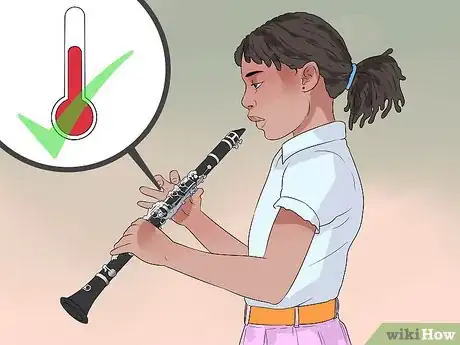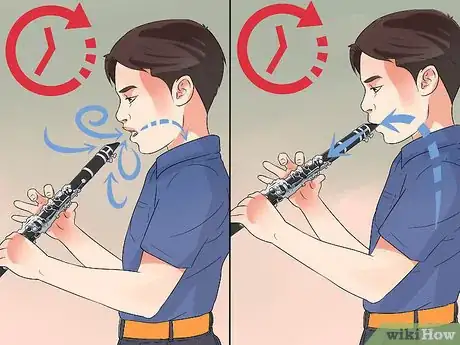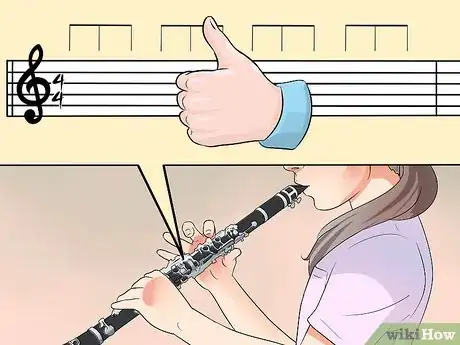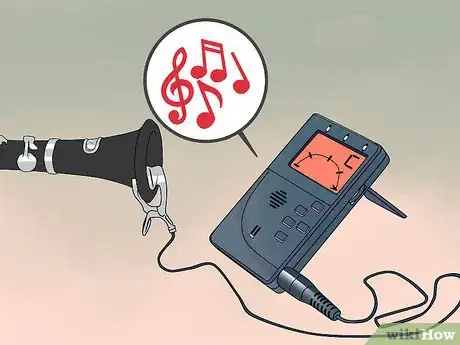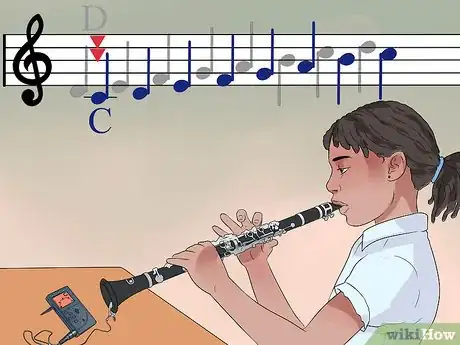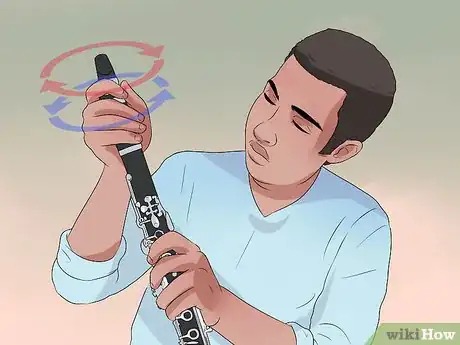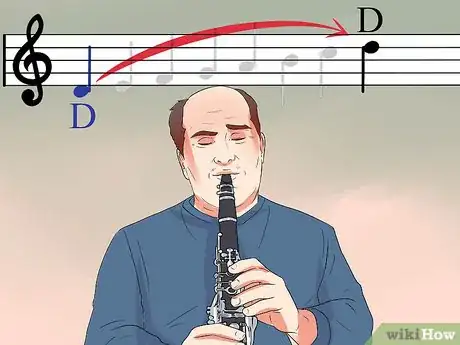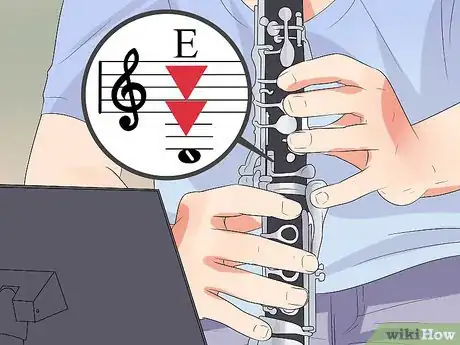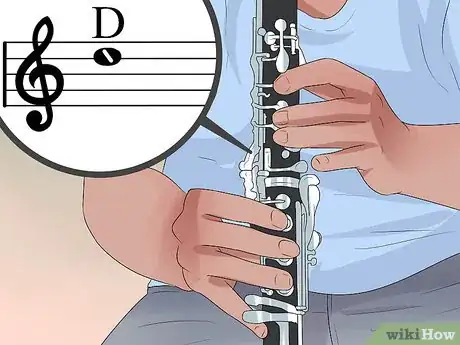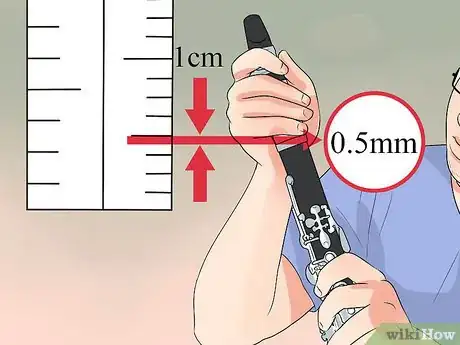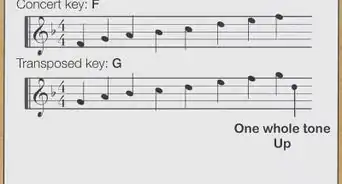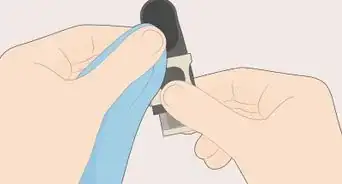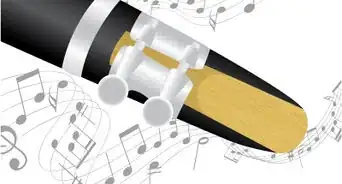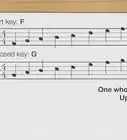This article was co-authored by wikiHow Staff. Our trained team of editors and researchers validate articles for accuracy and comprehensiveness. wikiHow's Content Management Team carefully monitors the work from our editorial staff to ensure that each article is backed by trusted research and meets our high quality standards.
This article has been viewed 122,018 times.
Learn more...
Whether you're playing in a concert band, marching band, orchestra, small ensemble, or even solo, playing at a perfect (or at least, near-perfect) pitch is important. While you must be on the correct pitch by yourself, you also have to be in tune with the rest of the group. Tuning can be difficult and confusing at first, but once you get the hang of it and develop a musical ear, it'll become second nature to you.
Steps
Warming Your Clarinet
-
1Understand the importance of warming. When you play the clarinet for an extended amount of time, your clarinet is warmed by your breath. As the clarinet warms from playing or from air temperature, the tuning becomes sharper, or higher pitched. Since the tuning is effected by heat, you should warm the clarinet before you play.[1]
-
2Finger a low “E.” Place your right hand to the lowest “E” note, but don't hold anything else down. You don't need to actually play a low “E.” By holding this note down, you can spread air through the clarinet more efficiently.Advertisement
-
3Blow air through the instrument. Take a deep breath before blowing air through the clarinet. Then extend a long flow of air through the clarinet. Again, you shouldn't hear any notes when you do this technique. Spend about five minutes warming your clarinet by using this technique.
-
4Play scales. Another way to warm up both your instrument and yourself is by practicing a few scales. Play through a range of minor, major, and pentatonic scales. Your clarinet may not sound in-tune, but it's more important to heat the instrument to an average playing temperature.[2]
- You can also practice melodies you are currently working on. Be sure to play with firm breathing instead of soft breathing while warming up.
-
5Repeat the blowing process. After playing through familiar scales, go back and simply blow air through the clarinet. Place your finger on a low "E" and blow air through the instrument. Imagine blowing hot air to warm your hands in the winter. Take this same breathing technique and apply it to the clarinet.
Tuning by Yourself
-
1Understand clarinet keys. Clarinets are designed to be transposed to match other players' keys. For most standard clarinets, you will be one whole tone flatter. A “C” for most instruments can be played by playing a “C,” but a clarinet will play a D to reach a “C.”[3]
- This is the reason people call the clarinet a transposing instrument. Transposing means to fix the notes to match up with the instrument. To transpose a piece for the clarinet, you would need to raise each note a whole step.
-
2Get a chromatic tuner. A standard chromatic tuner costs about $25 and can be found in any music shop or online. You can also download a chromatic tuner app for you smartphone, if you have the means. Chromatic tuners are ideal because they will show you what note you are playing.
- Make sure your tuner is set up with a microphone as opposed to being used as a guitar pedal.
- You can choose to tune to any key, but for this demonstration, tune to concert “C.” Concert “C” for most clarinets is D.
-
3Play the lower octave. It is best to start with the lower register of the clarinet and move down to the other sections. Play a low D while facing your tuner. The tuner should detect the note as around a C. It's okay if the note isn't in tune because you're going to fix that.
- Play a firm D and don't use a softer tone. Playing softly on the clarinet will produce a sharper tone.
-
4Adjust the barrel. Now you need to adjust the barrel to better tune your lowest octave. For sharp notes, you will extend your instrument. When you are too flat, you will shorten your instrument to sharpen the tone. Make your initial adjustments to the upper barrel about a half millimeter either by pulling or pushing. Play that same note and take note of your tuner.
- You'll probably need to experiment for a bit to get a close enough note. The ideal tune will be slightly sharp. Make sure the tuning needle is roughly in the center to indicate in-tune.[4]
- Make as many adjustments as needed.
-
5Play an octave sharper. Now play a D an octave higher while facing your tuner. For most clarinets, this octave is too sharp. Take note of what the chromatic tuner indicates. Tuning the higher pitched notes uses the same principles as the lower octave.[5]
-
6Adjust at the halfway point. Make your adjustments to the halfway part of the clarinet. If your D is sharp pull the clarinet about half a millimeter. Play the note again facing your tuner and see if you are closer to being in-tune. Continue to adjust until you've reached the sweet spot of being slightly sharp.
- Make sure you line up your bridge key properly before playing the higher notes.
-
7Test each note on the clarinet. Go through each note on your clarinet with your tuner. For your left-hand notes, or the lower octave, you will make any adjustments to the barrel. For any of the higher pitched notes, or the right handed notes, make adjustments at the halfway part of the clarinets.
Tuning with a Group
-
1Plan to tune with the group. If you are in an orchestra or band at school, the group will always have a note that everyone will tune with. Most will play a concert “C” or “G.” During rehearsals, your group will let you know what note they will be tuning to. You will be responsible for transposing a half note below the said note.
- If the band is tuning to a concert “C,” you will tune the clarinet to a D.[6]
-
2Play the lower octave. Always start with the lowest octave on your clarinet. Tuning with a band requires you to utilize your ears over anything else. Determine if your low octave is in-tune by focusing on your own sound in relationship to everyone else.
-
3Adjust the barrel. Make adjustments to the low octave by adjusting the upper barrel. Pull the barrel when sharp and push the barrel when flat. Make your adjustments in intervals of about half a millimeter.
- It's better to tune at home before practicing with the band. This way you are ready and won't need to make large tuning adjustments.
-
4Play an octave sharper. Usually a band will play the tuning note twice. The second time is for you to check the tuning of the higher octave of your clarinet. During the second duration of the tuning note, play the higher octave of D. Again, the higher octave is usually out of tune and a bit sharp.[7]
-
5Adjust at the halfway point. Make adjustments to the higher octave by adjusting the halfway section. Pull the halfway part when sharp and push the halfway part when flat. Make your adjustments in intervals of about half a millimeter.
- Make sure you line up your bridge key after making adjustments.
Community Q&A
-
QuestionHow do I place your reed in the right spot?
 Community AnswerA small hairline should be showing above the reed. Try to keep your reed centered.
Community AnswerA small hairline should be showing above the reed. Try to keep your reed centered. -
QuestionI did all of this, but whenever I play a low C, it says I am playing a low B flat.
 Community AnswerA C on the clarinet is a B flat on any other instrument in the key of C major.
Community AnswerA C on the clarinet is a B flat on any other instrument in the key of C major. -
QuestionHow do I know if the reed is wet enough?
 Community AnswerIf the reed isn't wet enough, the sound will be dry and airy.
Community AnswerIf the reed isn't wet enough, the sound will be dry and airy.
Warnings
- While some clarinet players swear by tuning rings, they are not necessary. Also, keep in mind that they need to be taken out to tune to a higher pitch, and can start buzzing when you tune a bit lower. If you're not up for the slight hassle, it's best not to use tuning rings.⧼thumbs_response⧽
- It's almost impossible to get every single note on the clarinet perfectly in tune, especially the very high, very low, and mostly open-holed ones. You should try, but it most likely won't be perfect.⧼thumbs_response⧽
References
- ↑ http://www.banddirector.com/article/pg-woodwinds/why-do-beginning-clarinet-players-play-flat
- ↑ https://www.bandworld.org/pdfs/SpringWarmUp.pdf
- ↑ https://www.flutetunes.com/articles/transpose-b-flat/
- ↑ http://www.ridenourclarinetproducts.com/tuning-the-clarinet.html
- ↑ http://www.banddirector.com/article/pg-woodwinds/why-do-beginning-clarinet-players-play-flat
- ↑ http://bandnotes.info/tidbits/scales/transposition.htm
- ↑ http://www.banddirector.com/article/pg-woodwinds/why-do-beginning-clarinet-players-play-flat
